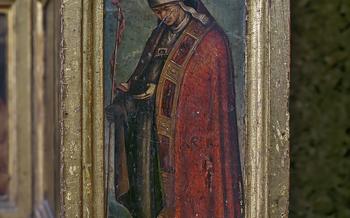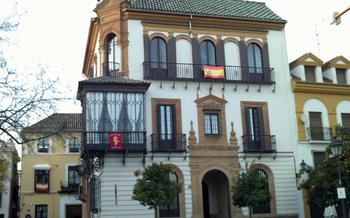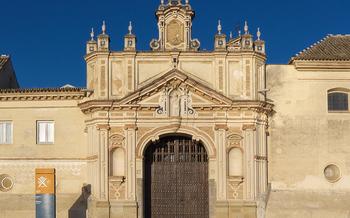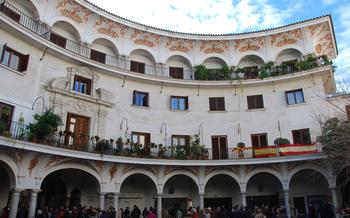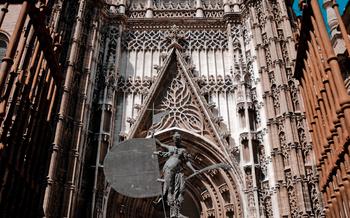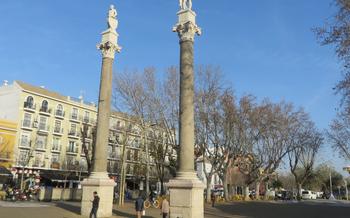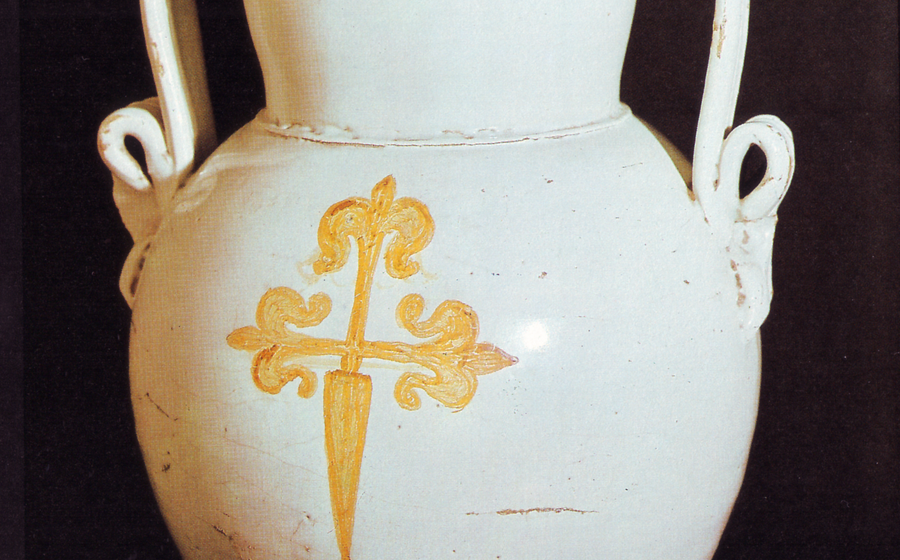
Casa de Murillo
- Casa de Murillo: A Glimpse into the Life of a Master
- Exploring the Museum
- Murillo's Artistic Legacy
- Murillo's Artistic Techniques
- Religious Themes and Imagery
- Portraits and Genre Scenes
- The Immaculate Conception
- The Prodigal Son Series: A Tale of Redemption and Repentance
- The Gypsy Madonna
- The Museo de Bellas Artes Sevilla
- Practical Information
- Events and Workshops
- Local Cuisine and Gastronomy
- Accommodations and Nearby Attractions
- Insider Tip
Casa de Murillo: A Glimpse into the Life of a Master
The Casa de Murillo is a museum dedicated to the life and works of Bartolomé Esteban Murillo, one of the most renowned artists of the Spanish Baroque period. Located in the heart of Seville, Spain, the museum offers a unique opportunity to explore the artistic legacy of this celebrated painter.
Murillo, born in Seville in 1617, rose to prominence as a leading figure of the Spanish Golden Age. His paintings, characterized by their vibrant colors, emotional depth, and mastery of chiaroscuro, earned him widespread recognition and admiration. The Casa de Murillo, housed in the artist's former residence, provides an intimate glimpse into the world and creative process of this influential master.
Visitors to the museum can trace Murillo's artistic journey through a collection of his most notable works, including religious paintings, portraits, and genre scenes. The museum's collection showcases the artist's unique style, which combined elements of naturalism, idealism, and a deep understanding of human emotion.
The Casa de Murillo stands as a testament to the enduring impact of Murillo's art on Spanish culture and the broader history of Western art. It invites visitors to immerse themselves in the life and legacy of this extraordinary artist, whose works continue to captivate and inspire audiences worldwide.
Exploring the Museum
The Casa de Murillo is a beautifully preserved 17th-century house that has been converted into a museum dedicated to the life and works of Bartolomé Esteban Murillo. The museum is divided into several sections, each of which offers a glimpse into the artist's life and creative process.
The first section of the museum focuses on Murillo's early life and career. Here, visitors can learn about his childhood in Seville, his apprenticeship with Juan del Castillo, and his early works. The second section features some of Murillo's most famous paintings, including "The Immaculate Conception" and "The Prodigal Son." These works showcase Murillo's mastery of color, light, and shadow, as well as his ability to capture the emotional intensity of religious scenes.
The third section of the museum explores Murillo's later works, including his portraits and genre scenes. These works offer a glimpse into the everyday life of 17th-century Seville, and they showcase Murillo's skill in capturing the human condition.
The Casa de Murillo also features a number of thematic exhibitions and special displays. These exhibitions often focus on specific aspects of Murillo's work, such as his use of color or his depiction of religious themes. The museum also offers guided tours and educational programs, which provide visitors with a deeper understanding of Murillo's life and art.
Murillo's Artistic Legacy
Murillo's works hold a significant place in the history of Spanish art, representing the culmination of the Baroque style and contributing to its evolution. His mastery of light, color, and composition set him apart as one of the most influential artists of his time.
Murillo's style was deeply rooted in the Baroque tradition, characterized by rich, vibrant colors, dramatic lighting, and an emphasis on movement and emotion. His ability to capture the essence of human experience, combined with his technical virtuosity, earned him widespread recognition and admiration.
Murillo's influence extended beyond his contemporaries, leaving a lasting impact on subsequent generations of artists. His innovative approach to painting and his ability to evoke powerful emotions and spiritual depth through his works inspired many aspiring artists, including Francisco Goya and Diego Velázquez.
Murillo's legacy continues to be celebrated and studied today, with his paintings featured in prominent museums and galleries around the world. His contributions to the development of Spanish art have solidified his position as a master of the Baroque period and a true icon of the art world.
Murillo's Artistic Techniques
Murillo's mastery of color, light, and shadow played a crucial role in creating the emotional depth and realism that characterized his works. His skillful use of color harmonies and contrasts, often employing warm and cool tones, allowed him to evoke a sense of atmosphere and create a sense of depth and perspective. Murillo's paintings were characterized by a soft, diffuse light that enveloped his subjects, creating a sense of serenity and spirituality. He also employed chiaroscuro, the use of contrasting light and shadow, to emphasize the three-dimensionality of his figures and to enhance the dramatic effect of his compositions.
Murillo's paintings were often infused with symbolism and allegorical elements, adding layers of meaning to his works. He employed symbolism to convey religious messages and moral lessons, often using objects, gestures, and colors to represent abstract concepts or emotions. His works often featured allegorical figures, such as angels, cherubs, and personifications of virtues, which served to reinforce the narrative and enhance the emotional impact of his paintings.
Murillo's emphasis on naturalism and emotional expression was evident in his portrayal of his subjects. He sought to capture the inner emotions and psychological states of his figures, often depicting them with a sense of humanity and empathy. Murillo's ability to convey the emotions of his subjects, whether joy, sorrow, or devotion, contributed to the emotional power and accessibility of his works.
In addition to his use of color, light, and shadow, Murillo employed various techniques to create depth and perspective in his paintings. He often used linear perspective, creating the illusion of receding space through the use of converging lines. He also employed aerial perspective, which involves the gradual تغییرof color and value to create the effect of distance. By skillfully combining these techniques, Murillo was able to create a sense of depth and realism in his paintings, drawing the viewer into his meticulously crafted world.
Religious Themes and Imagery
Murillo's deep-rooted faith and spirituality are evident in his prolific output of religious paintings. These works, which constitute a significant portion of his oeuvre, showcase his ability to convey profound religious messages through art.
One of the recurring themes in Murillo's religious paintings is the depiction of the Virgin Mary. He portrayed her in various roles and scenes, including the Immaculate Conception, the Annunciation, and the Assumption. His representations of the Virgin are characterized by their ethereal beauty, grace, and gentle expressions, capturing the essence of her purity and divinity.
Murillo also frequently depicted saints and biblical figures in his paintings. His works include representations of John the Baptist, Peter, Paul, and other saints, each imbued with unique characteristics and attributes. Through these paintings, Murillo sought to honor and celebrate the lives and virtues of these religious figures.
In addition to individual figures, Murillo also created narrative paintings that depicted biblical scenes, such as the Nativity, the Flight into Egypt, and the Last Supper. These works demonstrate his skill in storytelling and his ability to convey the emotional depth and spiritual significance of these events.
Murillo's religious paintings were not merely artistic creations but also expressions of his personal faith and devotion. Through his art, he sought to inspire and uplift viewers, encouraging them to contemplate the divine and the sacred.
Portraits and Genre Scenes
Murillo's skill in capturing human emotion and character extended beyond religious subjects. He also excelled in portraiture, capturing the essence of his subjects with remarkable sensitivity and realism. His portraits often depicted ordinary people from all walks of life, including children, elderly figures, and members of the aristocracy. Through these works, Murillo conveyed the social and cultural contexts of his time, providing a glimpse into the lives of his contemporaries.
Murillo's portraits are characterized by their psychological depth and emotional intensity. He imbued his subjects with a sense of individuality and personality, allowing viewers to connect with them on a personal level. His ability to convey emotions through facial expressions and gestures is evident in works such as "The Old Beggar" and "The Laughing Boy," which capture the essence of human joy and vulnerability.
In addition to portraits, Murillo also created genre scenes depicting everyday life and ordinary activities. These works offer a glimpse into the customs and traditions of 17th-century Seville. Murillo's genre scenes are often imbued with a sense of humor and warmth, capturing the nuances of human interactions and the beauty of everyday moments.
The Immaculate Conception
Throughout his career, Murillo explored the theme of the Immaculate Conception, a central doctrine in Catholic theology that refers to the belief in Mary's conception without original sin. His representations of this subject are characterized by their ethereal beauty and emotional intensity, capturing the moment when Mary, surrounded by a heavenly host, is imbued with divine grace.
Murillo's paintings of the Immaculate Conception showcase his mastery of color and light, with vibrant blues and whites creating a sense of celestial radiance. The Virgin Mary is often depicted with her hands clasped in prayer, her eyes downcast in humility, and her body enveloped in a luminous aura. The surrounding angels, with their delicate wings and expressive faces, add to the ethereal and mystical atmosphere of the compositions.
Beyond their artistic beauty, Murillo's Immaculate Conception paintings carry deep theological and symbolic meanings. The inclusion of the dove, representing the Holy Spirit, and the crescent moon beneath Mary's feet, symbolizing her triumph over sin, highlights the purity and divinity associated with her conception. These works served as powerful visual expressions of faith and devotion, inspiring viewers to contemplate the divine mystery of Mary's Immaculate Conception.
The Prodigal Son Series: A Tale of Redemption and Repentance
Murillo's renowned series of paintings depicting the parable of the Prodigal Son stands as a testament to his narrative prowess and emotional depth. The parable, recounted in the Gospel of Luke, tells the story of a young man who recklessly squanders his inheritance on a life of debauchery, only to return home in rags and repentance, where he is welcomed with open arms by his forgiving father.
Murillo's series of paintings captures the emotional journey of the prodigal son with poignant realism. The first painting depicts the son's departure, as he bids farewell to his father and embarks on his reckless path. The following scenes portray his descent into poverty and degradation, as he revels in worldly pleasures and falls into the company of questionable characters.
The culmination of the series showcases the son's realization of his follies and his humble return home. In a powerful scene, the father embraces his repentant son, embodying the essence of forgiveness and unconditional love. Murillo's masterful storytelling and ability to convey complex emotions through his art render this series a captivating and universally relatable narrative.
The Gypsy Madonna
Among Murillo's iconic works, "The Gypsy Madonna" stands out for its unique portrayal of the Virgin Mary as a gypsy woman. This unconventional representation reflects the cultural and historical context of Seville during the 17th century, where gypsy communities were a significant part of the city's population. Murillo's depiction of the Virgin Mary as a gypsy woman not only humanizes her but also challenges traditional iconography and highlights the diversity and inclusivity of the Catholic faith.
The painting captures the Virgin Mary in a tender embrace with the infant Jesus, both of whom are rendered with a striking realism and emotional depth. Mary's humble and compassionate expression conveys a sense of maternal love and protectiveness, while the intricate details of her clothing and the surrounding landscape further enhance the work's emotional resonance.
The symbolism and allegory of "The Gypsy Madonna" are also noteworthy. The Virgin Mary's association with the gypsy community represents her humility and closeness to the marginalized and oppressed. She is depicted as a symbol of compassion, acceptance, and maternal love, regardless of social or ethnic background. This unique interpretation of the Virgin Mary offers a fresh perspective on the traditional iconography, inviting viewers to contemplate the universality and diversity of the human experience.
From an artistic standpoint, "The Gypsy Madonna" showcases Murillo's masterful use of color, light, and shadow. The warm, earthy tones and soft, diffused lighting create a sense of intimacy and warmth, drawing the viewer into the emotional connection between Mary and Jesus. Murillo's attention to detail and skillful rendering of the figures, fabrics, and background further demonstrate his technical prowess and artistic virtuosity.
Overall, "The Gypsy Madonna" is a testament to Murillo's artistic genius and his ability to transcend traditional boundaries and create a deeply moving and thought-provoking work of art. It remains one of his most celebrated paintings and continues to captivate audiences with its unique iconography, emotional intensity, and technical mastery.
The Museo de Bellas Artes Sevilla
The Casa de Murillo is inextricably linked to the Museo de Bellas Artes Sevilla, a grand institution dedicated to preserving and showcasing the artistic heritage of Seville and beyond. Just a short walk from the Casa de Murillo, the museum houses an extensive collection that includes works by Murillo, as well as other renowned Spanish and European masters.
Established in 1841, the Museo de Bellas Artes Sevilla boasts a diverse array of artworks spanning from the Gothic period to contemporary times. Its collection includes masterpieces by artists such as Francisco Zurbarán, Diego Velázquez, and El Greco, to name a few. Visitors can trace the evolution of Spanish art through the centuries, exploring different styles, techniques, and themes.
The museum's collection is not limited to paintings; it also encompasses sculptures, ceramics, and decorative arts. Visitors can admire intricate religious sculptures, ornate pottery, and furniture that provide a glimpse into the cultural and artistic traditions of Seville.
By visiting the Museo de Bellas Artes Sevilla, visitors can gain a deeper understanding of Murillo's artistic trajectory and influence within the broader context of Spanish art. The museum offers a comprehensive overview of the artistic landscape of Seville and Spain, making it an essential destination for art enthusiasts and history buffs alike.
Practical Information
Address and Contact Details:
The Casa de Murillo is conveniently located at Calle Santa Teresa 8, just a short walk from the magnificent Seville Cathedral. For any inquiries or to plan your visit, you can reach the museum at (+34) 954 22 93 15 or through their official website.
Opening Hours:
The museum welcomes visitors from Tuesday to Saturday, offering ample opportunities to explore Murillo's masterpieces. Its doors are open from 10:00 AM to 6:00 PM, allowing you to immerse yourself in the artist's world at your own pace.
Admission Fees and Concessions:
Admission to the Casa de Murillo is reasonably priced, allowing art enthusiasts of all budgets to enjoy the museum's collection. A standard ticket costs €5, while concessions are available for students, seniors, and groups. Don't miss the opportunity to take advantage of these discounts and make the most of your visit.
Guided Tours and Audio Guides:
To enhance your experience, guided tours are available upon request at an additional cost. These tours offer a deeper dive into Murillo's life, techniques, and artistic legacy. Alternatively, you can opt for the audio guide service, which provides insightful commentary as you navigate the museum's exhibits.
Facilities and Amenities:
The Casa de Murillo is committed to providing a comfortable and accessible environment for all visitors. The museum features air-conditioning to ensure a pleasant experience regardless of the weather. Restrooms and a small gift shop are also available for your convenience.
Events and Workshops
Enrich your visit to the Casa de Murillo by participating in special events, workshops, and educational activities. The museum offers a range of programs designed to engage visitors of all ages and interests. Attend lectures, demonstrations, and hands-on art workshops led by experienced professionals. Learn about Murillo's techniques, artistic influences, and the context of his work through interactive sessions. Participate in sketching, painting, or creative writing workshops to channel your own artistic expression. Immerse yourself in the world of Baroque art and discover the enduring legacy of Bartolomé Esteban Murillo. Family-friendly events and activities are regularly organized to provide a fun and educational experience for visitors of all ages. These workshops and events offer unique opportunities to engage with art, explore your creativity, and gain a deeper appreciation for Murillo's masterpieces. Check the museum's website or inquire at the information desk for the latest schedule and details of upcoming events.
Local Cuisine and Gastronomy
Gastronomic adventures await visitors in Seville as they explore the city's vibrant culinary scene. To savor the authentic flavors of Spanish cuisine, consider venturing into the labyrinthine streets and discover hidden gems where locals indulge in traditional delights. In the vicinity of the Casa de Murillo, an array of restaurants, tapas bars, and mercados offer a delectable journey for food enthusiasts.
For a taste of traditional Andalusian cuisine, seek out establishments serving classics like gazpacho, a refreshing chilled tomato soup, and pescaíto frito, a medley of fried fish. Indulge in the iconic dish of Seville, solomillo al whisky, tender pork loin flamed in whiskey, and accompanied by a rich sauce.
Complement your culinary journey with a glass of local wine. The region of Andalusia boasts a rich winemaking tradition, producing a variety of white, red, and rosé wines. Explore the local vintages and pair them with your chosen dishes to elevate the dining experience.
Remember to embrace the vibrant atmosphere of Seville's culinary scene. Tapas bars, a hallmark of Spanish culture, offer a unique way to sample a variety of small plates and socialize with locals. Immerse yourself in the lively ambiance and indulge in the delectable offerings of this culinary paradise.
Accommodations and Nearby Attractions
When planning your visit to the Casa de Murillo, consider staying at one of the many charming hotels or guesthouses located within walking distance. Hotel Casa 1800 Sevilla, with its elegant rooms and rooftop terrace, offers stunning views of the city. Hotel Palacio de Villapanes, a restored 16th-century palace, provides a luxurious and authentic experience. For a more budget-friendly option, try Hotel Murillo, which offers comfortable rooms and a central location.
After exploring the Casa de Murillo, take advantage of the opportunity to visit other nearby attractions. The Real Alcázar, a magnificent palace complex with beautiful gardens, is just a short walk away. The Seville Cathedral, with its awe-inspiring architecture and Giralda Tower, is another must-see. For a taste of local culture, head to the lively Triana neighborhood, known for its vibrant flamenco scene and traditional tapas bars.
To make the most of your time in Seville, consider creating a personalized itinerary that combines cultural exploration with culinary experiences. Start your day with a visit to the Casa de Murillo, followed by a leisurely lunch at a nearby tapas bar. In the afternoon, explore the Real Alcázar and Seville Cathedral, and end the day with a flamenco show and dinner in Triana.
Insider Tip
For a truly unique experience, visit the Casa de Murillo during the annual Feria de Abril, Seville's renowned spring fair. During this festive week, the city comes alive with colorful tents, horse-drawn carriages, and traditional flamenco performances. Take advantage of the lively atmosphere to explore the fair, sample local delicacies, and immerse yourself in the vibrant culture of Seville.

